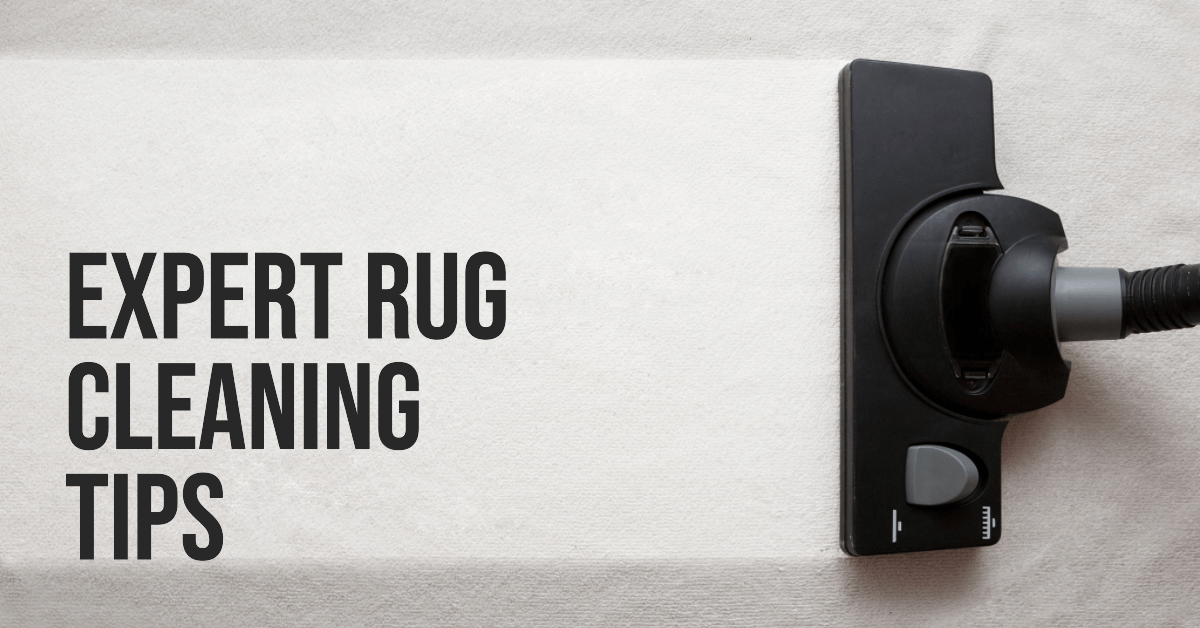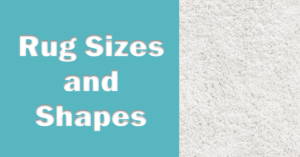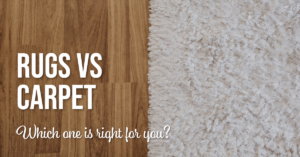As a professional interior designer, I cannot stress enough the importance of maintaining and caring for the beautiful rugs that adorn our homes. Not only do clean rugs create a visually pleasing environment, but they also play a significant role in maintaining a healthy living space. In this article, I’ll share my insights on the importance of rug cleaning, the benefits of proper maintenance, and an overview of the various rug cleaning methods you can employ to keep your rugs looking their best.
The Importance of Rug Cleaning
Rug cleaning is essential for many reasons. First and foremost, a clean rug contributes to the overall aesthetics of your living space. Imagine walking into a room with a stunning rug that is well-maintained, vibrant, and full of life – it can instantly elevate the entire atmosphere. On the other hand, a dirty, stained rug can have quite the opposite effect.
Aside from appearances, regular rug cleaning is crucial for maintaining a healthy environment. Rugs can trap dust, allergens, and bacteria, which can impact the air quality in your home. By keeping your rugs clean, you’re not only preserving their beauty but also ensuring a healthier living space for you and your family.
Benefits of Proper Rug Maintenance
Proper rug maintenance offers a host of benefits. For starters, it significantly prolongs the lifespan of your rugs, ensuring that your investment lasts for years to come. Regular cleaning also helps maintain the vibrancy and color of your rugs, preventing them from looking dull and worn over time.
Moreover, proper rug maintenance can reduce the chances of mold and mildew growth, which can cause unpleasant odors and even pose health risks. Lastly, well-maintained rugs are less likely to attract pests such as carpet beetles, which can cause extensive damage to your precious rugs.
Overview of Various Cleaning Methods
There’s no one-size-fits-all approach when it comes to cleaning rugs. Different rug types and materials require specific cleaning techniques to ensure the best results. Here’s a brief overview of some of the most common rug cleaning methods:
- Vacuuming: An essential part of regular rug maintenance, vacuuming removes loose dirt and debris from the rug’s surface. It’s crucial to choose the appropriate vacuum cleaner settings and attachments for your rug type to avoid causing damage.
- Spot Cleaning: Ideal for treating small stains and spills, spot cleaning involves applying a gentle cleaning solution directly to the affected area and gently blotting the stain with a clean cloth or sponge.
- Shampooing: This method involves using a specialized rug shampoo and a soft brush to gently scrub the rug’s surface. It’s crucial to choose the right shampoo for your rug material and follow the manufacturer’s instructions for the best results.
- Steam Cleaning: Also known as hot water extraction, steam cleaning involves using a machine that sprays hot water mixed with a cleaning solution onto the rug, then extracts the dirty water. This method is particularly effective for deep cleaning and sanitizing rugs, but it’s essential to ensure your rug is suitable for steam cleaning before proceeding.
In the following sections, we’ll dive deeper into these methods and explore additional techniques tailored to specific rug materials. Armed with this knowledge, you’ll be well-equipped to keep your rugs looking their best and ensure their longevity.
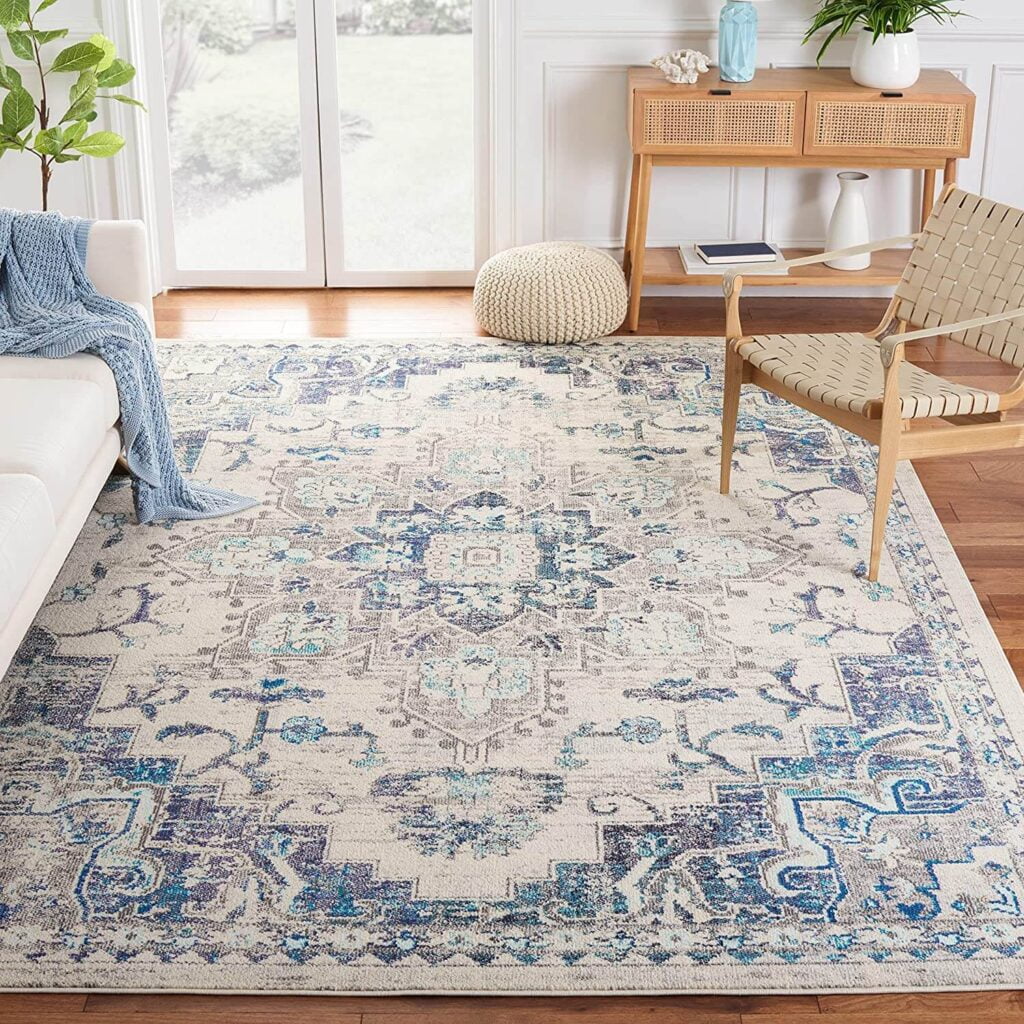
Photo: Safavieh Madison Collection
The Best Way to Clean Your Rug
Over the years I’ve encountered countless rugs in various shapes, sizes, and materials. Each rug has its unique charm and requires a tailored approach to cleaning and maintenance. In this section, I’ll discuss some essential factors to consider when determining the best way to clean your rug and provide guidance on selecting the most suitable cleaning method.
Factors to Consider
When deciding on the best cleaning method for your rug, it’s essential to consider several factors:
- Rug Type: Area rugs, oriental rugs, and other specialty rugs each have specific cleaning requirements. Make sure you’re aware of your rug’s unique needs before attempting any cleaning method.
- Size: The size of your rug can significantly impact the cleaning process. Smaller rugs can often be taken outdoors and cleaned more thoroughly, while larger rugs may require in-place cleaning.
- Material: Your rug’s material is a crucial factor in determining the best cleaning method. For instance, delicate materials like silk or antique rugs require extra care, while synthetic rugs are more durable and can handle a more rigorous cleaning approach.
Overview of Cleaning Methods
Now that you understand the factors to consider let’s discuss some common rug cleaning methods and their suitability for different rug types:
- Vacuuming: Vacuuming is a crucial first step in maintaining the cleanliness of any rug. It removes surface dirt, dust, and debris, and should be done regularly regardless of the rug type or material. Be sure to use the appropriate vacuum cleaner settings and attachments to avoid causing damage to your rug.
- Spot Cleaning: This method involves treating small stains or spills as they occur. Use a gentle cleaning solution specifically designed for your rug material, and gently blot the stain with a clean cloth or sponge. It’s essential to address stains promptly, as they can become more challenging to remove over time.
- Shampooing: Shampooing is an effective way to deep clean your rug, but it’s essential to choose a shampoo specifically designed for your rug’s material. Use a soft brush or sponge to gently work the shampoo into the rug’s fibers, then rinse thoroughly with water. Make sure to remove as much excess water as possible and allow the rug to dry completely before placing it back in your living space.
- Steam Cleaning: Steam cleaning, also known as hot water extraction, is a powerful deep-cleaning method that can help remove stubborn dirt and bacteria from your rug. However, this method is not suitable for all rug types, particularly those made from delicate materials. Before attempting steam cleaning, check your rug’s care label or consult with a professional to ensure it’s an appropriate cleaning method for your rug.
When it comes to rug cleaning, there’s no one-size-fits-all approach. By considering the factors mentioned above and selecting the most suitable cleaning method for your specific rug, you’ll be well on your way to maintaining its beauty and ensuring it remains a cherished centerpiece in your home for years to come.
Tools and Supplies Needed for DIY Rug Cleaning
While professional cleaning services are always an option, many of us prefer to take matters into our own hands when it comes to rug care. If you’re planning to tackle rug cleaning yourself, having the right tools and supplies is essential. In this section, I’ll share my recommendations for the must-have items you’ll need for a successful DIY rug cleaning session.
Essential Tools and Supplies
- Vacuum Cleaner: A high-quality vacuum cleaner is a must-have for any rug cleaning project. Look for a model with adjustable settings and specialized attachments to ensure you can effectively remove dirt and debris without causing damage to your rug’s fibers.
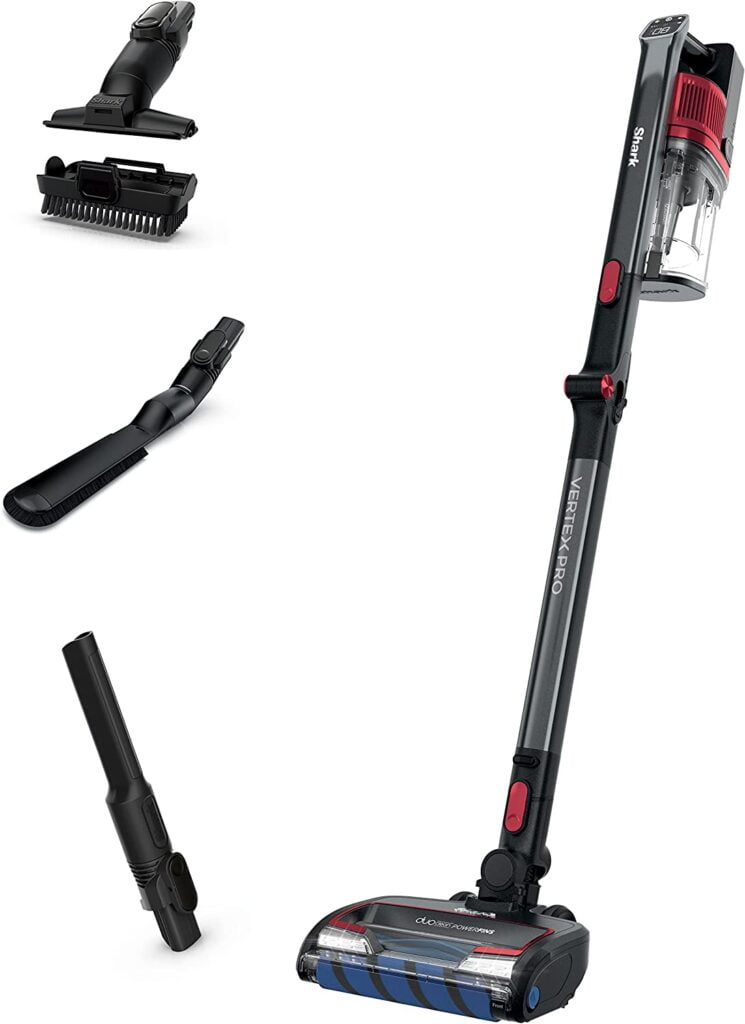
- Soft-Bristled Brush or Sponge: To gently scrub your rug during shampooing or spot cleaning, opt for a soft-bristled brush or sponge. These tools allow you to work cleaning solutions into your rug’s fibers without causing unnecessary wear and tear.
- Clean, White Cloths or Towels: You’ll need clean, white cloths or towels for blotting stains during spot cleaning and removing excess water after shampooing or rinsing. White is preferred to avoid color transfer onto your rug.
- Bucket: A large bucket is useful for mixing cleaning solutions and holding water during the cleaning process. Choose a sturdy, easy-to-carry option that can hold enough water for your rug’s size.
- Gentle Rug Shampoo or Cleaning Solution: Select a gentle rug shampoo or cleaning solution specifically formulated for your rug’s material. Be sure to follow the manufacturer’s guidelines for dilution and usage to achieve the best results.
- Rubber Gloves: Protect your hands from harsh cleaning solutions by wearing rubber gloves during the cleaning process. This will also help you maintain a better grip on your tools and supplies.
- Spray Bottle: Fill a spray bottle with water to dampen your rug before cleaning and to rinse off the cleaning solution after scrubbing. This will help ensure an even application and thorough rinsing.
- Large Tarp or Plastic Sheet: Protect your floors by laying down a large tarp or plastic sheet underneath your rug during the cleaning process. This will catch any excess water and prevent damage to your flooring.
- Fans or Dehumidifier: Properly drying your rug after cleaning is crucial to prevent mold and mildew growth. Using fans or a dehumidifier will help speed up the drying process and ensure your rug is completely dry before returning it to your living space.
With these essential tools and supplies at hand, you’ll be well-equipped to tackle your DIY rug cleaning project with confidence. Remember to follow the manufacturer’s guidelines for your rug’s specific material, and don’t hesitate to consult a professional if you’re unsure about the best cleaning approach for your rug.
Deep-Cleaning Interior Rugs
Deep-cleaning your rugs not only enhances their appearance but also extends their lifespan. In this section, I’ll share with you three effective methods for deep-cleaning interior rugs: shampooing with a machine, steam cleaning, and hand washing and spot cleaning. By incorporating these techniques into your rug maintenance routine, you can keep your rugs looking their best for years to come.
Shampooing with a Machine
Using a carpet cleaner or rug shampooer is an efficient way to deep-clean your rugs. These machines inject a mixture of cleaning solution and water into the rug’s fibers, then extract the dirt and grime along with the excess moisture. Here’s how to shampoo your rug with a machine:
- Preparation: Vacuum your rug thoroughly to remove loose dirt and debris. Pre-treat any visible stains with a gentle stain remover, following the manufacturer’s instructions.
- Shampoo the Rug: Fill the carpet cleaner’s tank with a cleaning solution and water, as per the manufacturer’s guidelines. Adjust the machine’s settings according to your rug’s material and thickness. Carefully pass the machine over your rug, making sure not to oversaturate it.
- Dry the Rug: After shampooing, allow your rug to air-dry completely. Use fans or a dehumidifier to speed up the drying process if necessary. Once the rug is dry, vacuum it once more to fluff up the fibers.
We Recommend

Transform your cleaning routine with the Bissell ProHeat 2X Revolution Max Clean Pet Pro, a robust carpet and rug cleaner designed specifically for pet-friendly homes. Its remarkable suction power effortlessly tackles dirt, dust, and pet hair, leaving your carpets and rugs immaculate.
The ProHeat 2X Revolution Max Clean Pet Pro is not just about power; it’s also about smart cleaning. It features the unique Heatwave Technology that leverages heat to loosen stubborn dirt and stains, ensuring a thorough clean.
Moreover, it comes with a range of versatile attachments, simplifying the task of cleaning different surfaces. Despite its powerhouse performance, it’s surprisingly user-friendly and reasonably priced.
Pros:
- Exceptional suction power for deep cleaning
- Heatwave Technology for enhanced stain removal
- Range of attachments for various cleaning tasks
- User-friendly and budget-friendly
Cons:
- Could be a bit noisy for some users
- Slightly bulky
- Brush roll cleaning can be a little tricky
In a nutshell, the Bissell ProHeat 2X Revolution Max Clean Pet Pro is a fantastic carpet cleaner choice, especially for pet owners. Combining power, innovative technology, and ease of use, it delivers a top-notch performance that’s hard to beat. While it may have a few minor drawbacks, its advantages clearly outweigh them, making it a worthwhile consideration for your next carpet cleaner.
Experience superior cleaning today with the Bissell ProHeat 2X Revolution Max Clean Pet Pro!
Steam Cleaning
Steam cleaning is an excellent alternative to shampooing, as it uses the power of hot water and steam to lift dirt and grime from your rug’s fibers without the need for chemicals. Here’s how to steam clean your rug:
- Preparation: Vacuum your rug to remove loose dirt and debris. Pre-treat any visible stains with a gentle stain remover, following the manufacturer’s instructions.
- Steam Clean the Rug: Fill the steam cleaner’s tank with water, and allow the machine to heat up. Slowly pass the steam cleaner over your rug, taking care not to oversaturate it. The hot steam will loosen dirt and grime, which can then be vacuumed away.
- Dry the Rug: Allow your rug to air-dry completely. Use fans or a dehumidifier to speed up the drying process if necessary. Once the rug is dry, vacuum it again to fluff up the fibers.
Hand Washing and Spot Cleaning
For delicate, antique, or specialty rugs, hand washing and spot cleaning may be the safest approach. Follow these steps to hand wash and spot clean your rug:
- Preparation: Vacuum your rug to remove loose dirt and debris. Pre-treat any visible stains with a gentle stain remover, following the manufacturer’s instructions.
- Hand Wash the Rug: Mix a gentle rug cleaning solution with water, following the manufacturer’s guidelines for dilution. Using a soft-bristled brush or sponge, gently work the solution into the rug’s fibers, focusing on stained areas and high-traffic sections.
- Rinse and Dry the Rug: Rinse the rug with clean water, taking care to remove all traces of the cleaning solution. Blot the rug with clean, white towels or cloths to remove excess moisture. Allow the rug to air-dry completely, using fans or a dehumidifier to speed up the drying process if necessary.
By incorporating these deep-cleaning methods into your rug maintenance routine, you can ensure your rugs remain beautiful and functional for years to come. Remember that some rugs may require professional cleaning services, so don’t hesitate to consult an expert if you’re unsure about the best approach for your
Step-by-Step Guide to Cleaning an Area Rug
A clean and well-maintained area rug not only enhances the aesthetics of your space but also promotes a healthier living environment. In this section, I’ll provide you with a step-by-step guide to cleaning your area rug, making it as simple and hassle-free as possible.
1. Clear Furniture and Objects Off the Rug
Begin by removing any furniture, accessories, or other objects from your rug. This ensures that you have full access to the rug’s surface and prevents any damage to your belongings during the cleaning process.
2. Remove Dirt and Debris
With the rug fully exposed, use a vacuum cleaner to remove loose dirt and debris from its surface. Be sure to vacuum both sides of the rug, as dirt can accumulate on the underside as well.
3. Mix the Cleaner
Prepare a cleaning solution by mixing a gentle rug cleaner with water, following the manufacturer’s instructions for the proper dilution ratio. Make sure to choose a cleaner that is suitable for your rug’s material and colorfastness.
4. Perform a Color Test
Before applying the cleaning solution to your rug, perform a color test to ensure the solution won’t cause any fading or discoloration. Dab a small amount of the solution onto a hidden area of the rug, then blot with a clean, white cloth. If no color transfers onto the cloth, it’s safe to proceed with the cleaning.
5. Wash the Rug
Using a soft-bristled brush or sponge, gently work the cleaning solution into the rug’s fibers. Focus on stained or high-traffic areas, taking care not to oversaturate the rug.
6. Rinse the Rug
After washing, thoroughly rinse the rug with clean water to remove all traces of the cleaning solution. Use a garden hose or a bucket of water, making sure to rinse the entire rug evenly.
7. Remove Excess Water
To remove excess water from your rug, use a squeegee, a clean, dry towel, or even a wet-dry vacuum. Gently press the tool against the rug’s surface to extract as much water as possible.
8. Let the Rug Dry
Allow the rug to air-dry completely, ideally in a well-ventilated area or outdoors. Be sure to dry both sides of the rug, flipping it over halfway through the drying process. You can also use fans or a dehumidifier to speed up the drying process if necessary.
9. Vacuum or Brush Out the Rug
Once the rug is completely dry, give it a final vacuum or brush out to fluff up the fibers and restore its original texture. This step also helps to remove any remaining dirt or debris that may have been loosened during the cleaning process.
By following this step-by-step guide, you can keep your area rug looking its best and ensure a clean, inviting living space. Don’t forget to clean your rug regularly, and consider professional cleaning services for particularly delicate or valuable rugs.
Rug Material Specific Cleaning Techniques
Different types of rugs require specific cleaning techniques to preserve their beauty and longevity. In this section, I will share my expertise on how to clean rugs made from different materials, ensuring the best results for your cherished home accessory.
How to Clean Woven or Braided Rugs
Woven or braided rugs are often made from cotton or wool, and require special care during cleaning. To clean these rugs, follow these steps:
- Vacuum the rug thoroughly on both sides to remove dirt and debris.
- Use a mild detergent mixed with warm water to create a gentle cleaning solution.
- Apply the solution to the rug using a soft-bristled brush or sponge, gently scrubbing in a circular motion.
- Rinse the rug thoroughly with clean water, taking care not to oversaturate it.
- Press out excess water with a clean, dry towel or a squeegee.
- Lay the rug flat to air-dry in a well-ventilated area.
How to Clean Hand-Knotted, Antique, and Oriental Rugs
Hand-knotted, antique, and oriental rugs require special attention to maintain their intricate designs and delicate fibers. To clean these rugs, follow these steps:
- Vacuum the rug gently, using a brushless attachment to avoid damaging the fibers.
- Test a small, inconspicuous area with a mild rug cleaner to ensure it won’t cause fading or discoloration.
- Gently clean the rug using a soft-bristled brush or sponge, working in small sections.
- Rinse the rug with clean water, taking care not to oversaturate it.
- Blot out excess water with clean, dry towels.
- Lay the rug flat to air-dry in a well-ventilated area, away from direct sunlight.
How to Clean Coir, Sisal, Rush, and Grass Rugs
Natural fiber rugs, such as coir, sisal, rush, and grass, require special care to maintain their durability and appearance. To clean these rugs, follow these steps:
- Vacuum the rug thoroughly to remove dirt and debris.
- Spot-clean any stains using a soft-bristled brush and a gentle cleaning solution, taking care not to oversaturate the fibers.
- If a more thorough cleaning is needed, use a slightly damp cloth to wipe down the rug in the direction of the fibers.
- Blot any excess moisture with a clean, dry towel.
- Allow the rug to air-dry completely in a well-ventilated area.
How to Clean Fur, Sheepskin, and Hair-on Hide Rugs
Fur, sheepskin, and hair-on hide rugs require specific care to maintain their softness and shine. To clean these rugs, follow these steps:
- Gently brush the rug with a soft-bristled brush or comb to remove any tangles and debris.
- If necessary, spot-clean stains using a mild detergent mixed with water, taking care not to oversaturate the rug.
- Rinse the cleaned area with a damp cloth, then blot dry with a clean towel.
- Allow the rug to air-dry completely, preferably in a well-ventilated area.
- Once dry, gently brush or comb the rug to restore its softness and shine.
By understanding and implementing these rug material-specific cleaning techniques, you can keep your treasured rugs in pristine condition and maintain their beauty for years to come.
Deep-Cleaning a Rug by Hand
As an interior design professional, I know that sometimes, a good old-fashioned hand cleaning is just what your rug needs to restore its original beauty. Hand cleaning allows for greater control and attention to detail, ensuring that every part of your rug gets the proper care it deserves. In this section, I will share some techniques and tips for deep-cleaning a rug by hand, as well as the pros and cons of this method.
Techniques and Tips
- Vacuum thoroughly: Start by vacuuming both sides of the rug to remove dirt and debris. This will make the cleaning process more effective and prevent the dirt from spreading.
- Spot-treat stains: Before deep-cleaning, treat any stubborn stains with a mild rug cleaner, using a soft-bristled brush or sponge to gently work the cleaner into the fibers.
- Prepare a cleaning solution: Mix a mild detergent with lukewarm water in a bucket. Avoid using harsh chemicals or hot water, as they can damage delicate rug fibers.
- Gently scrub: Dip a soft-bristled brush or sponge into the cleaning solution, and gently scrub the rug in a circular motion, working on small sections at a time.
- Rinse thoroughly: Use a clean, damp cloth to rinse the cleaning solution from the rug. Be sure to remove all soap residue, as it can attract dirt and cause the rug to become soiled more quickly.
- Blot out excess water: Press a clean, dry towel against the rug to remove as much excess water as possible.
- Dry the rug: Lay the rug flat to air-dry in a well-ventilated area, away from direct sunlight. Turn the rug periodically to ensure even drying.
- Restore the rug’s appearance: Once the rug is completely dry, use a soft-bristled brush or vacuum to restore its texture and fluffiness.
Pros and Cons
Pros:
- Hand-cleaning allows for greater control and attention to detail, ensuring that every part of your rug gets the proper care it deserves.
- This method is gentler on delicate rug fibers, reducing the risk of damage.
- Hand-cleaning is more cost-effective than hiring professional rug cleaners or renting equipment.
Cons:
- Hand-cleaning can be labor-intensive and time-consuming, especially for larger rugs.
- The drying process can take longer than with machine cleaning methods, increasing the risk of mold and mildew growth if the rug is not dried properly.
- Hand-cleaning may not be as effective as professional cleaning or machine methods for removing deep-set dirt and stains.
Deep-cleaning a rug by hand can be a rewarding and effective way to maintain the beauty and longevity of your cherished home accessory. By following the techniques and tips outlined above, you can give your rug the thorough cleaning it deserves while preserving its delicate fibers and vibrant colors.
Cleaning Large Area Rugs at Home
As someone with extensive experience in the world of home design, I’m well aware of the challenges involved in maintaining large area rugs. They can truly elevate the look and feel of a space, but keeping them clean can be a daunting task due to their size and weight. Don’t worry, though; with the right approach and techniques, you can effectively clean your large area rugs at home. In this section, I’ll share some tips on moving and handling large rugs, as well as suitable cleaning methods to keep them looking their best.
Moving and Handling Large Rugs
- Enlist help: Due to the size and weight of large area rugs, it’s always best to have someone help you move and handle them. This will make the process safer and more efficient.
- Roll, don’t fold: When moving a large rug, it’s crucial to roll it rather than fold it. Folding can cause creases and damage to the rug’s fibers. Start at one end, keeping the rug as tight and even as possible, and roll it all the way to the other end.
- Secure the rug: Use a sturdy rope or straps to secure the rolled rug, preventing it from unrolling during the moving process.
- Protect the rug: If you need to transport the rug, cover it with a plastic sheet or tarp to protect it from dirt and damage.
Suitable Cleaning Methods
- Vacuuming: Regular vacuuming is essential to keep your large area rug clean and free of dirt, dust, and allergens. Be sure to vacuum both sides of the rug and use a brush attachment for the edges.
- Spot cleaning: Attend to spills and stains promptly to prevent them from setting. Use a mild rug cleaner and a soft cloth or sponge to gently dab at the affected area.
- Shampooing with a machine: Renting a carpet cleaner or rug shampooer is an effective way to deep-clean a large area rug. Be sure to follow the manufacturer’s instructions and use a gentle, rug-safe cleaning solution.
- Steam cleaning: A professional-grade steam cleaner can be an excellent option for cleaning large area rugs, as it effectively loosens dirt and kills bacteria without using harsh chemicals. Always follow the steam cleaner’s instructions and avoid over-wetting the rug.
- Hand washing: While it can be labor-intensive, hand washing a large area rug can be a suitable method if you have the space and time. Follow the same steps as mentioned in the “Deep-Cleaning a Rug by Hand” section, but keep in mind that you’ll need to dedicate more time and effort to handle the larger rug size.
By following these guidelines for moving, handling, and cleaning your large area rugs, you can keep your cherished home accessories looking fresh and vibrant for years to come. Regular maintenance and proper cleaning techniques will go a long way in preserving the beauty and lifespan of your large area rugs.
Need help on Cleaning a Pink Rug, Rug Source has a great article on this that we reccomend.
Traditional Rug Cleaning Methods: Do They Still Work?
Lets look at traditional rug cleaning methods that have been passed down through generations. In today’s world, where technology and modern cleaning solutions abound, it’s worth exploring whether these time-honored techniques still hold up. In this section, we’ll take a closer look at the traditional practice of beating rugs with a broom, as well as other age-old rug cleaning methods, and assess their effectiveness in comparison to contemporary techniques.
Beating Rugs with a Broom
Beating rugs with a broom is a classic cleaning technique that many of us have seen our grandparents or great-grandparents employ. The principle is simple: hang the rug over a clothesline or railing and beat it with a broom to dislodge dust and dirt.
While this method can help remove surface dirt, it’s not as effective at extracting deeply embedded dirt and allergens from the rug fibers. Additionally, beating a rug with a broom can be physically demanding and may cause damage to the rug’s fibers and structure, especially if it’s an antique or delicate piece.
In light of these considerations, I would suggest that beating rugs with a broom is not the most effective or gentle method for maintaining your rugs. Modern vacuum cleaners equipped with HEPA filters and brush attachments are far more efficient at removing dirt, dust, and allergens without causing damage to your precious rugs.
Other Traditional Techniques
- Sunlight exposure: Hanging a rug out in the sun was a common practice to help remove odors and kill bacteria. While sunlight does possess natural sanitizing properties, excessive exposure can cause fading and damage to the rug fibers. Instead, consider using a gentle rug cleaner or professional cleaning service to address odors and bacteria.
- Hand washing: Hand washing a rug with water and a mild soap or detergent is another traditional technique that can be effective for certain types of rugs. However, it’s essential to ensure that the rug is thoroughly rinsed and dried to prevent mold and mildew growth. For larger or more delicate rugs, professional cleaning services may be a safer option.
- Snow cleaning: In colder climates, it was customary to clean rugs by laying them on fresh snow and using a broom or brush to scrub the surface. While this method can remove surface dirt, it’s not as thorough as modern cleaning techniques, and it may not be suitable for delicate or antique rugs.
In conclusion, while traditional rug cleaning methods may still have their place, it’s important to recognize that modern cleaning techniques offer more effective and gentle solutions for maintaining your rugs. By staying informed and adapting your cleaning practices as needed, you can ensure that your rugs remain a beautiful and cherished part of your home for years to come.
How Often Should You Clean Your Area Rugs?
I frequently receive questions about rug maintenance and how often area rugs should be cleaned. After all, rugs are an essential part of your home’s décor and play a vital role in creating a comfortable, inviting atmosphere. To help you determine the ideal cleaning schedule for your rugs, let’s discuss the factors you should consider and the recommended cleaning frequency.
Factors to Consider
- Foot traffic: The level of foot traffic your rug is subjected to plays a significant role in determining how often it needs to be cleaned. High-traffic areas, such as hallways, entryways, and living rooms, tend to accumulate dirt, dust, and allergens more quickly, which necessitates more frequent cleaning.
- Pets: If you have pets, you may need to clean your rugs more frequently to remove pet hair, dander, and any accidental stains or odors.
- Allergies: If you or anyone in your household suffers from allergies, it’s crucial to maintain a clean home environment. Frequent rug cleaning can help minimize allergens and create a healthier living space.
- Rug material: The type of material your rug is made from can also impact how often it should be cleaned. For example, delicate or antique rugs may require special care, while more durable materials may be able to withstand more frequent cleaning.
Recommended Cleaning Frequency
With these factors in mind, here are some general guidelines for how often you should clean your area rugs:
- Vacuuming: For high-traffic areas and homes with pets, vacuum your rugs at least once a week to remove surface dirt and debris. For low-traffic areas or homes without pets, vacuuming every two weeks should suffice.
- Spot cleaning: Address spills and stains as soon as they occur to prevent them from setting in and becoming permanent. Regular spot cleaning helps maintain your rug’s appearance and prolong its lifespan.
- Deep cleaning: Aim to deep clean your rugs every 12 to 18 months to remove embedded dirt, allergens, and grime. If you have a high-traffic area or pets, you may need to deep clean more frequently—every 6 to 12 months. For delicate or antique rugs, consult a professional cleaning service to determine the appropriate cleaning frequency and method.
By taking these factors into consideration and following the recommended cleaning frequency, you can ensure that your area rugs remain a beautiful, functional, and long-lasting addition to your home.
How to Remove Stains from Rugs
Accidents happen, but knowing how to tackle these pesky stains can make all the difference in preserving your rug’s beauty and value. In this section, we’ll discuss some common types of stains and provide a step-by-step guide to help you effectively remove them from your rugs.
Common Types of Stains
- Food and beverage spills: Wine, coffee, tea, and juice are common culprits for rug stains. These can be particularly tricky to remove if not addressed promptly.
- Pet stains: Accidents involving pets can leave behind unpleasant odors and stains, which may require special treatment.
- Ink stains: Ink from pens or markers can be challenging to remove, especially on lighter-colored rugs.
- Grease and oil stains: These stains can be difficult to remove due to their oily nature, but with the right approach, they can be effectively tackled.
- Mud and dirt: Tracked-in mud and dirt can be unsightly and may even damage the rug fibers if left untreated.
Step-by-Step Stain Removal Guide
- Blot the stain: As soon as a spill occurs, use a clean, dry cloth to blot up as much of the liquid as possible. Work from the outer edges of the stain towards the center to avoid spreading it further.
- Identify the stain type: Determine the type of stain you’re dealing with, as different stains may require different cleaning solutions and techniques.
- Test your cleaning solution: Before applying any cleaning solution, test it on a small, inconspicuous area of the rug to ensure it won’t cause any discoloration or damage.
- Apply the cleaning solution: For most stains, a mixture of water and mild dish soap can be used. However, some stains may require a specific cleaner. For instance, use a specialized pet stain remover for pet accidents, and use rubbing alcohol or a specialized ink remover for ink stains. Apply the solution to a clean cloth and gently dab the stain, again working from the outer edges towards the center.
- Rinse and blot: After treating the stain, use a cloth dampened with clean water to rinse the area. Be sure not to oversaturate the rug, as this can lead to water damage. Blot the area dry with a clean, dry cloth.
- Dry the rug: Allow the treated area to air dry completely. You can speed up the drying process by using a fan or a hairdryer set on the lowest heat setting.
- Vacuum or brush: Once the rug is completely dry, vacuum or brush the fibers to restore their natural appearance.
With this step-by-step guide, you’ll be well-equipped to tackle common rug stains and keep your area rugs looking fresh and beautiful. Remember, acting quickly and using the right cleaning solutions can make all the difference when it comes to stain removal.
Cleaning Area Rugs Made from Natural Fibers
As an interior designer with years of experience, I’ve come to appreciate the beauty and versatility of natural fiber rugs. Jute, sisal, and other natural fibers bring an organic warmth to any space, making them a popular choice for many homes. However, these materials require specific care and cleaning methods to maintain their unique textures and appearances. In this section, I’ll share my tips for cleaning jute, sisal, and other natural fiber rugs.
Jute Rug Cleaning
Jute rugs are known for their durability and soft texture, but they can be sensitive to moisture. To clean a jute rug:
- Vacuum regularly: Vacuum your jute rug at least once a week to remove dirt and debris, using a vacuum cleaner with a brush attachment to avoid damaging the fibers.
- Blot spills immediately: In case of spills, blot the area with a clean, dry cloth as soon as possible to prevent staining.
- Spot clean with a mild detergent: Mix a small amount of mild dish soap with water and gently dab the stained area with a soft cloth. Avoid rubbing the stain, as this can damage the rug’s fibers.
- Dry the rug: After spot cleaning, use a clean, dry cloth to blot the area and remove excess moisture. Allow the rug to air dry completely before walking on it.
Sisal Rug Cleaning
Sisal rugs are known for their robustness and natural beauty but require special care to maintain their appearance. To clean a sisal rug:
- Vacuum regularly: Use a vacuum cleaner with a brush attachment to remove dirt and debris from your sisal rug. Vacuum both sides of the rug to ensure thorough cleaning.
- Blot spills immediately: As with jute rugs, blot any spills as soon as they occur to prevent staining.
- Spot clean with a mild detergent: For stains, use a cloth dampened with a mixture of water and mild dish soap. Gently dab the stain without rubbing, as this can damage the fibers.
- Dry the rug: After spot cleaning, blot the area with a clean, dry cloth to remove excess moisture. Allow the rug to air dry completely.
Other Natural Fiber Rugs
When cleaning other natural fiber rugs, such as seagrass, coir, or abaca, follow the same general guidelines as for jute and sisal rugs. Remember that natural fiber rugs are sensitive to moisture, so avoid soaking them or using harsh chemicals that may cause damage.
By following these cleaning tips, you’ll be able to maintain the beauty and durability of your natural fiber rugs for years to come. Regular vacuuming, prompt attention to spills, and gentle spot cleaning with mild detergents are essential to keeping these unique and eco-friendly rugs looking their best.
Rug Cleaning FAQs
What is the best way to clean my rug?
The best way to clean your rug depends on its material and size. Regular vacuuming is essential for all types of rugs, and spot cleaning with a mild detergent can help remove stains. For a deeper clean, you may consider steam cleaning, shampooing with a machine, or hand washing, depending on the rug’s specific care instructions.
What tools and supplies do I need to clean an area rug at home?
To clean an area rug at home, you’ll need a vacuum cleaner with a brush attachment, mild dish soap or rug cleaner, a soft cloth or sponge, a bucket or spray bottle, clean water, and a few clean, dry towels. You may also need a rug brush or comb, particularly for rugs with a high pile or shaggy texture.
How do you deep-clean an interior rug?
Deep-cleaning an interior rug involves a more thorough cleaning process than regular maintenance. Depending on the rug’s material and care instructions, you can deep-clean it by shampooing with a machine, steam cleaning, or hand washing and spot cleaning. Always follow the manufacturer’s guidelines for the specific rug to avoid causing damage.
How do you clean area rugs made from fibers like jute?
Cleaning area rugs made from natural fibers, such as jute, requires specific care to avoid damaging the fibers. Regular vacuuming with a brush attachment is essential, and spot cleaning with a mild detergent and water mixture can help remove stains. Be gentle when cleaning these rugs, and avoid soaking them or using harsh chemicals.
How do you deep-clean a rug by hand?
Deep-cleaning a rug by hand involves using a mild detergent and water mixture to gently wash the rug, paying close attention to stained or soiled areas. After washing, rinse the rug thoroughly with clean water, and remove excess water by blotting with clean, dry towels. Allow the rug to air dry completely before walking on it or replacing furniture.
How do you clean a large area rug at home?
Cleaning a large area rug at home may require moving it outside or to a spacious indoor area for easier handling. Follow the same cleaning methods as for smaller rugs, such as vacuuming, spot cleaning, and, if necessary, deep-cleaning using a machine, steam cleaning, or hand washing.
My grandma would beat her rugs clean with a broom. Does this method work?
Beating rugs with a broom can help remove dirt and dust, but it’s not the most effective or recommended method for modern rug cleaning. Today, vacuuming, spot cleaning, and deep-cleaning using appropriate tools and methods are more effective and gentle on the rug’s fibers.
How often should I clean area rugs?
The frequency of cleaning area rugs depends on factors such as foot traffic, pets, and allergies. In general, it’s recommended to vacuum area rugs at least once a week and deep-clean them every 12 to 18 months. However, you may need to clean them more frequently if they’re in high-traffic areas or if you have pets or allergies.
Conclusion
In this comprehensive guide, we’ve explored the importance of proper rug care and various cleaning techniques to keep your rugs looking their best. From the materials used in their construction to the specific cleaning methods suited for each type, understanding how to care for your rugs is crucial for maintaining their beauty and longevity.
To recap, we’ve discussed the importance of regular maintenance, such as vacuuming and spot cleaning, as well as deep-cleaning techniques like shampooing with a machine, steam cleaning, and hand washing. We’ve also delved into material-specific care, emphasizing the unique requirements for natural fiber rugs, antique and oriental rugs, and rugs made from more delicate materials like fur and sheepskin.
In closing, remember that taking good care of your rugs not only enhances the beauty of your interior spaces but also extends the life of these valuable investments. By following the tips and techniques shared in this guide, you’ll be well on your way to preserving the quality and appearance of your area rugs for years to come.
If you’re still in the process of picking out the perfect rug for your home, don’t miss our comprehensive guide, ‘The Ultimate Guide to Choosing the Perfect Rug for Your Home‘, which can help you make an informed choice.

